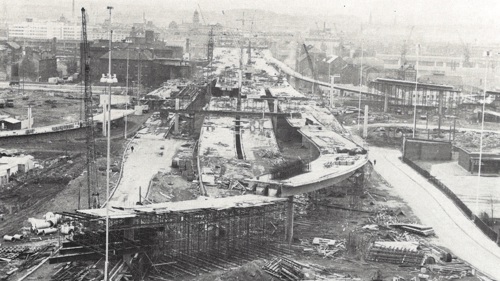The M8 in Glasgow - Times past

In partnership with the Glasgow Times, our archivists are exploring Glasgow's fascinating history. This week, Barbara McLean writes about the M8 in Glasgow.
“Oh, we’re going home to Glasgow, its face is on my mind. Its laugh is loud and gallus, its arms are warm and kind!”.
My sister and I used to belt that out in the car coming home to Glasgow, much to the annoyance of the rest of the family. It was part of the soundtrack to our return journeys on the motorway as it took us home from our trips to Greenock and Edinburgh.
That motorway was the M8, the busiest motorway in Scotland and one of the busiest in Europe. It’s also the principal road connection between Glasgow and Edinburgh. It’s a lengthy route and most of it was built in stages across fifteen years (1965 – 1980) although additional building did take place in later years.
In Glasgow itself, it’s also an infamous route. It destroyed parts of the city by cutting through its centre. Anderston, in particular, lost swathes of its historic streets and buildings including Anderston Library in McIntyre Street, a Carnegie library. Other notable buildings which fell to the wrecking ball include the Kinning Park Public Baths, the Grand Hotel at Charing Cross and the St Andrew’s Ambulance Association Headquarters in North Street. Those who’d lived in these areas had to be re-housed elsewhere. The public outcry against the destruction was huge and led to the M8 becoming the last motorway to be built through a city centre in the UK.
The Kingston Bridge, a huge ten-lane road bridge, is the instrument by which the M8 is carried across the river Clyde and through the city centre. Designed by W. A. Fairhurst and Partners, consulting engineers, and begun in May 1967, it was opened by the Queen Mother on 26 June 1970. The occasion was marked with a commemorative souvenir brochure produced by Glasgow Corporation and now held in our collections.
We also hold the Fairhurst Negatives, a significant photographic collection which charts the development of the company’s projects, including the Kingston Bridge. Once completed, the bridge became the largest urban bridge in the country with its main part spanning 470 feet across the river.
The Kingston Bridge is also a part of the M8 originally intended to act as the western and northern flanks of the Inner Ring Road. Its eventual abandonment rendered it incomplete and led to several unusual features of the existing M8. For example, there was a proposal in 1965 (A Highway Plan for Glasgow), which would have seen the construction of Maryhill Motorway. The proposed motorway would have branched off at the north-west corner of the ring road.
Although never built, this motorway has still impacted the present M8. Multiple slip roads leaving and joining the motorway from the right-hand side were introduced. This feature, more commonly seen in American highways, was introduced to reduce the anticipated weaving of traffic as it tried to join the Maryhill Motorway. Instead, it’s made driving on the M8 through central Glasgow a challenge, to say the least.
“Oh, we’re going home to Glasgow…”
